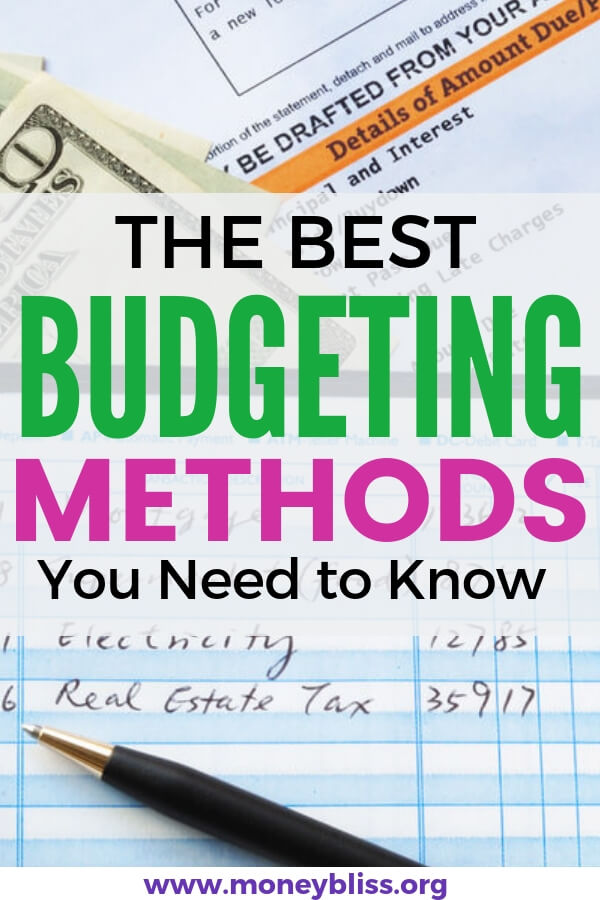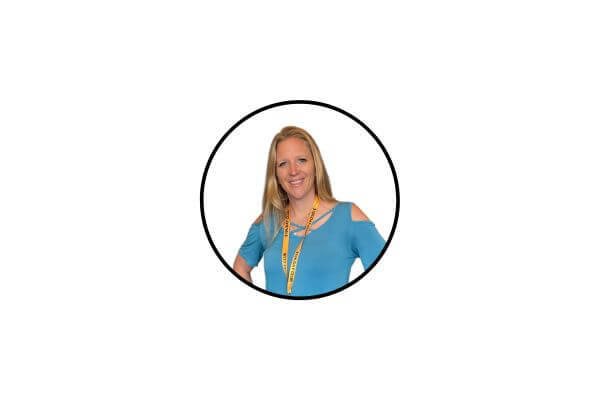The Best Methods of Budgeting You Need to Know
This post may contain affiliate links, which helps us to continue providing relevant content and we receive a small commission at no cost to you. As an Amazon Associate, I earn from qualifying purchases. Please read the full disclosure here.
There are tons of ways to budget and many of the ideas actually cross over
And honestly, that is the reason that budgeting is hard. I get it. Budgeting can get complicated if you feel you are putting a square into a circle. So, you need to find a budgeting method that works for you.
In just a minute, we will outline the best ways to budget your money.
The biggest key to making a budget is to make a budget and stick to it. Not for a day or two. But, for years to come.
A budget becomes such a part of your life that you don’t know anything different.
Regardless of the method of budgeting, the goal at the end of the month is to spend less than you made. Period.
It doesn’t matter how you get there; it just has to happen.

Five Methods of Budgeting Plus One for Haters
As you read the various method of budgeting, realize that each of the methods may cross over.
Many people may take bits and pieces to form their method of budgeting. And that is awesome!
In the end, there is no wrong or right way to budget. Just something that work for you.
1. Traditional Budgeting
Traditional budgeting comes from the corporate world since that is where it is normally used. It takes into account how expenses and revenue were spent in previous years and forecasts any foreseeable changes for the upcoming year.
Advantages –
This is great for a company and/or person who has been budgeting a long time and the budget thing has become old hat to them. Everything stays consistent going forward.
It is very simple to make small adjustments (or forecasts) to the foreseeable future. For instance, to account for an increased inflation rate.
Disadvantages –
The biggest disadvantage to traditional budgeting is it assumes you are going to stay on the same trajectory.
For those needing a budget for beginners, this is not the method of budgeting I would recommend. Typically, beginning budgeters are looking to change their habits and live within their means. So, taking previous spending and expenses is only going to produce the same habits.
Traditional Budgeting Process:
The process for traditional budgeting happens in four steps.
- The first is to analyze spending for a set period of time. Highly recommended to look back at least one year to account for those annual irregular expenses
- Then, with a traditional budget, you develop a plan on how to spend your money. The key is keeping your expenses below income.
- Decide how you plan to maintain the budget. Will you use cash envelopes? Or a digital version of cash envelopes?
- Lastly, over time, revise the amount of money allocated to any specific category. This is when you fine tune how your spending compares to money goals.
2. Percentage Budgeting

This method of budgeting is also known as percentage based budgeting. Many people have heard of the 80/20 budget (spend 80% and save 20%) or 50/30/20 budget (necessities 50%, wants 30% and 20% to debt or savings).
Here at Money Bliss, we like to use the Cents Plan Formula:
- Save: Greater than 20%
- Give: 10%
- Basic Expenses: Less than 50%
- Fun Spending: 20%
- Debt: 0%
With this type of budgeting method, your budget is guided by a proportion formula. The key word is guide.
Curious to know what other spend on average? Find out with the household budget percentages.
Advantages:
This is a great place to start making a budget when you don’t have a clue where to start budgeting.
Using the Cents Plan Formula as a guide, it gives you flexibility in your budget to adjust categories as you pay off debt or lower basic expenses. Then, freeing up money to go towards savings or giving or just plain fun spending.
Disadvantages:
This assumes you have the same money goals as everyone else. Managing money is a very personal journey specific to you.
Also, with a percentage budget, a gray area develops of what is classified as a basic expense and fun spending.
Percentage Budgeting Process:
- Take your income and multiply by each percentage in the Cents Plan Formula.
- Align your budget to stay within the percentage allocated to that category.
- Make sure spending is within the limits of the percentage budget.
3. Zero Based Budgeting

The concept of Zero Based Budgeting is simple. Each month the plan is to spend all of your income. Thus, getting the budget to zero.
Income – Expenses (and savings) = Zero
Zero based budgeting is when you create a new budget each month to make sure money is allocated to cover all expenses and that every penny is accounted for. Building the budget happens around the upcoming period of time typically monthly or bi-weekly.
Advantages –
With a zero based budget, every single penny is accounted for and has a purpose.
For those who tend to stray from a budget, this type of budget helps to stay focused on “spending” all income before the money hits your bank account.
Having a plan is key to reach long term success.
Disadvantages –
You must create a new budget every single month. This can be cumbersome for those who want to spend less time on managing finances.
The number #1 reason I don’t recommend the zero based budgeting approach when you have many irregular expenses in one month.
For us, September is a very expensive month. Both car registrations are due along with kid’s school fees and sports activities. And we can’t forget the lovely annual sewer bill. That is typically $1000 out of the monthly budget.
If you don’t have money set aside for these additional expenses than your budget is blown and most people give up. Thus, going back to old habits.
Zero Based Budgeting Process:
- First, take all of your income sources for the upcoming period either monthly or biweekly.
- Then, list all of your expenses for the upcoming month. This includes every expense as well as any saving or paying off debt you want to include.
- Next, look at your plan. Are you overspending? Or underspending?
- If you are overspending, then you need to reduce your expenses for the month in one or more categories.
- If you are underspending, then you need to save that money or put it towards debt.
- Remember, the goal is for every penny to be accounted for and reach zero.
- Stick to your zero based budget.

4. Sinking Fund Budgeting

The sinking fund budgeting is for the person who always wants to know there is enough money to cover expenses.
Also, a sinking fund budget works extremely well for the cash envelope system. For many people, they have multiple savings accounts where money is transferred each month.
Basically, a sinking fund is money set aside for a future purchase or need. Find more in-depth understanding of how sinking funds work plus sinking fund examples.
By using a sinking fund budget, you are better able to anticipate expenses as well as have the ebb and flow of money set aside in various categories.
Advantages:
The biggest advantage of sinking fund budgeting is there is always cash available when needed and there is no need to go into debt.
This allows for flexibility in the budget. For instance, spending a higher dollar amount for groceries around the holidays than a “normal” month.
Easy to track using cash envelopes, app, or pencil and paper.
Disadvantages:
Sometimes it can be hard to start sinking funds when funds are limited and / or changing to this method of budgeting.
Hard to track if you aren’t the analytical type of person and doesn’t care to match up the categories to the sinking funds.
Sinking Fund Budgeting Process:
- Write down the guaranteed income.
- Determine how much you want to allocate to each sinking fund. A sinking fund budget includes the amount you plan to save and give.
- Make sure your expenses or less than income.
- For the cash envelope system, divide up your cash into various sinking funds. Or use an online option.
5. Backwards Budgeting

This type of budgeting is also known as reverse budgeting. This budgeting method takes into account saving first. Plain and simple, you pay yourself before money is spent anywhere else.
The backwards budgeting method is very simple.
Most people start with a percentage to save when creating a budget. With their savings percentage of anywhere between 20-50% of their income. That doesn’t mean you shouldn’t choose this method of budgeting; it means that you have to start from zero saving percentage at some point.
Also, backwards budgeting is a great way to increase your savings percentage each and every year.
The same method also helps you to give a higher savings percentage as well.
The primary advantage to backwards budgeting is it allows you to put your money exactly where it matters most to you. You manage your money and don’t have your money mange you.
Advantages –
One of the biggest advantages to this type of budgeting is you decide how much to save first. By paying yourself first, the possibility to reach your goals faster comes true.
The out of sight, out of mind concept. If I don’t see money in my back account, then the less money I spend.
Disadvantages –
With backwards budgeting, many people get tied up in saving a certain percentage of income, that they miss out on life. Memories can’t be made with money sitting in a bank account. So, you have to weigh the choices of spending money vs. saving money.
Backwards budgeting is much harder if there isn’t enough money to cover all of the expenses. However, it prioritizes the spending on what is and isn’t essential.
Backwards Budgeting Process:
- Take your income (net of taxes).
- Then, make decisions on the dollar amount you want to save or what percentage to save.
- Next, basic expenses are taken care of with backwards budgeting.
- The remaining amount is dedicated to discretionary expenses or additional savings.
Key Point – To be successful with backwards budgeting, you must know what your life’s vision is. What do you want from life and how does money correlate to your vision? If you are unsure, our full length course, My Ultimate Money Blueprint will guide you.
Related resource: Does Being Frugal Mean you are Cheap?
6. Budgeting for People That Hate Budgeting

For some people, they could care less in the world on what and where money was spent from. At the end of the day, all they want to know is they are working towards their life visions and spending less than they make.
The key with this type of budget is to make budgeting as simple as possible.
The simpler, the better.
Advantages –
This gives those who hate to budget some flexibility and not be tied down to categories.
This method of budgeting can be done with cash, debit or credit card. The key is to remember whatever your number to spend would be.
Disadvantages –
The possibility to overspend is much, much higher with this method of budgeting.
Just because of the flexibility of not having the categorization of other types of budgeting methods, it doesn’t mean you can cover up the root cause of your money troubles.
The Hate Budgeting Process:
Again, the simplicity here comes from putting most of their spending and saving on autopilot. So, upfront will take more time than on a monthly basis.
- Add up all expenses related to basic expenses (ie: rent, insurance, heat, etc), planned savings, and giving for the entire year. Pretty much all of those expenses that are consistent each and every month. For instance, each month the rent/mortgage is $1500. The insurance bill is $285. Find the list of budget categories. Take that number and divide by 12.
- Next, take your income and subtract it from the 12-month expense number from above.
- The remaining amount is the amount to spend on everything else. This would range from gas to groceries to eating out to entertainment. That is the amount you have left to spend. Period.
Bonus Tip: Since the hate budgeting method allows for more fluidity, it is possible to spend more than you planned on in a given month. So, adding a buffer of 5-15% would be helpful depending on the type of spender you are.
What Budgeting Methods have you Heard Of?

Regardless of the method of budgeting you choose, remember to use the guaranteed money that will come in and every month like clockwork. Anything above that amount needs to be handled with the irregular income swings.
While there are many methods to budgeting, it all comes down to the same thing…
How do you want to manage your money?
That one pivotal question is the whole reason for budgeting.
Related Budgeting Resources:
- How to Budget Money and Still Enjoy Life
- 9 Surprising Advantages of Budgeting your Money
- How to Make a Budget in 7 Simple Steps
- Do You Know the Ideal Household Budget Percentages?
- Complete Guide to Sinking Funds – Why They are So Important?

Did the post resonate with you?
More importantly, did I answer the questions you have about this topic? Let me know in the comments if I can help in some other way!
Your comments are not just welcomed; they’re an integral part of our community. Let’s continue the conversation and explore how these ideas align with your journey towards Money Bliss.

